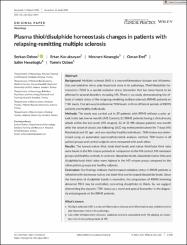| dc.contributor.author | Özben, Serkan | |
| dc.contributor.author | Küçüksayan, Ertan | |
| dc.contributor.author | Köseoğlu, Mesrure | |
| dc.contributor.author | Erel, Özcan | |
| dc.contributor.author | Neşelioğlu, Salim | |
| dc.contributor.author | Özben, Tomris | |
| dc.date.accessioned | 2023-11-30T06:54:13Z | |
| dc.date.available | 2023-11-30T06:54:13Z | |
| dc.date.issued | 2021 | en_US |
| dc.identifier.uri | https://www.scopus.com/record/display.uri?eid=2-s2.0-85105173710&origin=resultslist&sort=plf-f&src=s&nlo=&nlr=&nls=&sid=20c4fe371b9b908d4f7e419f791331ff&sot=aff&sdt=cl&cluster=scofreetoread%2c%22all%22%2ct&sl=34&s=AF-ID%2860198720%29+AND+SUBJAREA%28MEDI%29&relpos=108&citeCnt=4&searchTerm= | |
| dc.identifier.uri | https://hdl.handle.net/20.500.12868/2441 | |
| dc.identifier.uri | https://onlinelibrary.wiley.com/doi/pdf/10.1111/ijcp.14241?utm_source=scopus&getft_integrator=scopus | |
| dc.description.abstract | Background: Multiple sclerosis (MS) is a neuroinflammatory disease and inflammation and oxidative stress play important roles in its pathology. Thiol/disulphide homeostasis (TDH) is a special oxidative stress biomarker that has been found to be
affected in several disorders including MS. There is no study demonstrating the effects of attack status of the relapsing-remitting multiple sclerosis (RRMS) patients on
TDH levels. Our aim was to determine TDH levels in three different periods of RRMS
patients and healthy individuals.
Methods: The study was carried out in 29 patients with RRMS without a prior attack in the last twelve months (MS Control), 21 RRMS patients having a clinical acute
attack within the last week (MS relapse), 12 of 21 MS relapse patients one month
after the onset of attack and following 1000 mg methylprednisolone for 7 days (MS
Remission) and 30 age- and sex-matched healthy individuals. TDH status was determined using an automated spectrophotometric analysis method. TDH levels in all
patient groups and control subjects were compared with each other.
Results: The lowest native thiol, total thiol levels and native thiol/total thiol ratio
were found in the MS relapse patients in comparison to the MS control, MS remission
groups and healthy controls. In contrast, disulphide levels, disulphide/native thiol and
disulphide/total thiol ratios were highest in the MS relapse group compared to the
other patient groups and healthy subjects.
Conclusion: Our findings indicate that increased oxidative stress in RRMS patients is
reflected with decreased native and total thiol and increased disulphide levels. Since
the formation of disulphide bonds is reversible, the progression of RRMS involving
abnormal TDH may be controlled, converting disulphides to thiols. So, we suggest
determining the dynamic TDH status as a novel and special biomarker in the diagnosis and prognosis of the RRMS patients.
What’s known
• Multiple sclerosis (MS) is a neuroinflammatory disease and inflammation and oxidative stress
play important roles in its pathology.
• Like other inflammatory diseases, oxidative stress is associated with MS playing an important role in the pathogenesis of MS.
What’s new
• Our study provides original data on dynamic Thiol/disulphide homeostasis (TDH) status
in the relapsing-remitting multiple sclerosis (RRMS) patients at three different periods of
the disease and examines whether plasma TDH can be used as a special oxidative stress
biomarker in the diagnosis and follow-up of the RRMS patients and their response to the
therapy | en_US |
| dc.language.iso | eng | en_US |
| dc.relation.isversionof | 10.1111/ijcp.14241 | en_US |
| dc.rights | info:eu-repo/semantics/closedAccess | en_US |
| dc.title | Plasma thiol/disulphide homeostasis changes in patients with relapsing-remitting multiple sclerosis | en_US |
| dc.type | article | en_US |
| dc.contributor.department | ALKÜ, Fakülteler, Tıp Fakültesi, Temel Tıp Bilimleri Bölümü | en_US |
| dc.identifier.volume | 75 | en_US |
| dc.identifier.issue | 7 | en_US |
| dc.relation.journal | International Journal of Clinical Practice | en_US |
| dc.relation.publicationcategory | Makale - Uluslararası Hakemli Dergi - Kurum Öğretim Elemanı | en_US |


















